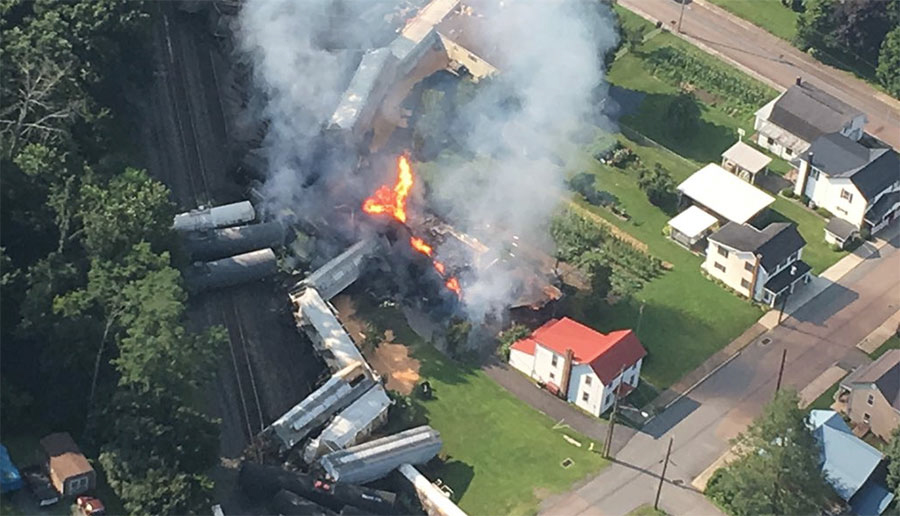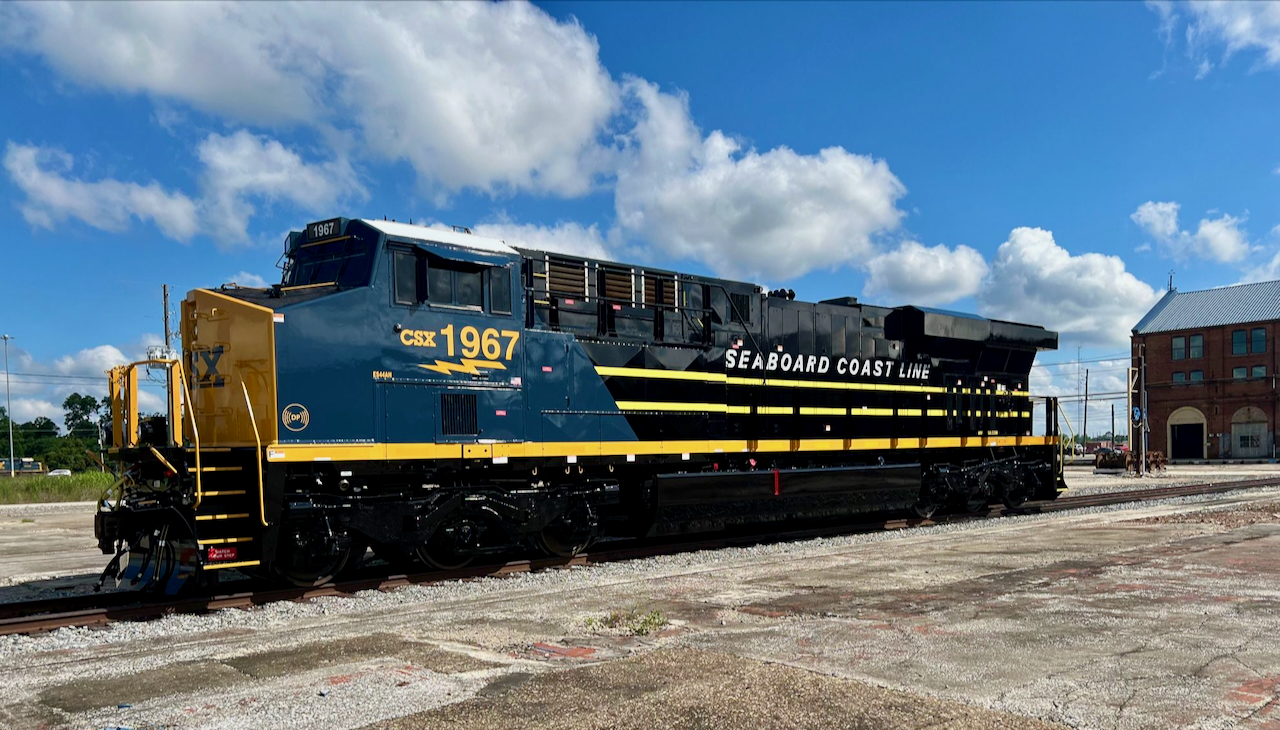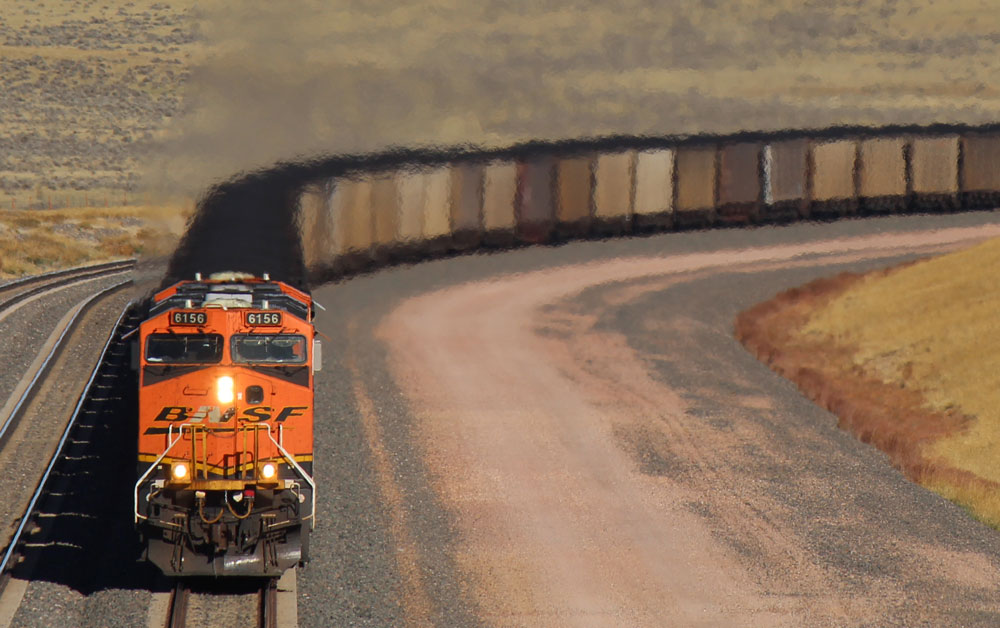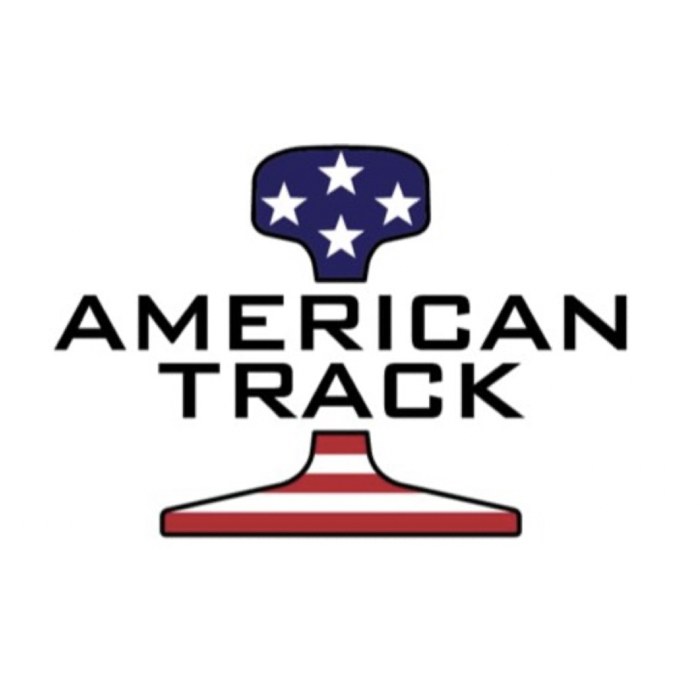According to a preliminary report released today from investigators of the National Transportation Safety Board, CSX train Q38831 had 5 locomotives and 178 cars — 128 loaded and 50 empties — when it moved through Hyndman, Pa., on Aug. 2. Thirty-two of those cars derailed toward the head-end of the train as it moved from Chicago to upstate New York.
The shells on three derailed tank cars, one each hauling propane, asphalt, and molten sulphur, breached, with the propane and sulphur loads catching fire and forcing evacuation of the neighboring community of about 1,000 residents.
NTSB investigators write that two CSX crews touched the train immediately before the crash. The first crew stopped the train on a descending grade because of brake air line problems. That crew applied 58 hand brakes to secure the train and ran out of service hours while a railroad carman repaired the line. A second crew relieved the first and kept the handbrakes on believing that the train might still have problems with the brake air line. When the second crew could not pull the train, they released 25 hand brakes and began moving with 33 hand brakes set.
One car derailed on a curve shortly before the main derailment, which began at a highway grade crossing. Investigators write that wheels before and after the first derailed car had flat spots, built-up tread, and blued steel from the hand brakes keeping wheels from turning or turning normally.
The Federal Railroad Administration, CSX Transportation, the Brotherhood of Locomotive Engineers and Trainmen, the International Association of Sheet Metal, Air, Rail and Transportation Workers, and the Pennsylvania Public Utilities Commission are all parties to the derailment investigation.















“Harrison’s fascination with mega-trains and eliminating helper districts just to please the stockholders…”
Didn’t please me. No longer a stockholder.
The STB report stated that the engr after starting down the grade used dynamic braking some and put the engs back in power 2 or 3 times before the derailment. He had no control of the train while descending, only if he had DPU power further back at least 2/3 of the train or on the rear and of course trained to use it.
Retainers could have been used while moving the train. While the hand brakes were applied the engr. could have made a service application of the brakes and the retainers set, all of the hand brakes could be released and train moved until it was off the mountain. Then the retainers could be set to the off position. With over 16,000 tons behind these empties there is no guarantee that the derailment would not have occurred anyway.
All that was needed was to have a curve for an empty to pick up a wheel and derail which did happen.
You don’t move trains with hand brakes set, especially if you didn’t set them yourself. This was a train for a seasoned Road Foreman to have accompanied the crew on this route, but heck, they’ve all been cut off.
128 loads and 50 empties? That’s two trains. Mr. Harrison’s fascination with mega-trains and eliminating helper districts just to please the stockholders isn’t working– just ask the customers.
Shorter trains would be more efficient while offering better service. Take it from an old freight dog.
I’d also like to know what role retainers could have (should have) played. And :bump: to Mr. Conaway’s question – what is standard practice regarding moving a train with handbrakes set?
Yes, Mr. Crowe, what about retainers? Wouldn’t turning these up have helped on a long, heavy train heading downgrade? Could someone in operations comment on this?
178 Cars, 2 Engines, 3 DIC, Hyndman, PA.. EHH “R-U” NUTS,
Darn. Guess we can’t blame it on Hunter!
Retainers?
Two points need to be made.
First, CSX was reportedly trying longer consists prior to EHH.
Second, it seems the second crew and the first crew did not communicate very well and as a result the second crew did not know how many handbrakes had been set. Therefore they released enough to get the train moving while the rest were not allowing the wheels to turn or to turn normally.
That latter point seems to be a factor, but the unanswered question is how bad the derailment might have been if all cars were rolling as designed. There could have been a lot more momentum involved.
The big question remains. Why did EHH route this train over Sand Patch when the water level route to Selkirk is not only flatter, but a lot shorter.
Huh only 2 of the 5 engines were online the other 3 were DIC. So the effective HP was more like .5 HP a ton max. You have to like EHH and his road drags. No power to climb no DB;s and your screwed.
Based on the NTSB report, I correct myself – why pulling 18,000 tons at 1.2 hpt?
Or perhaps Res ipsa loquitor may come into play? The thing explains itself….
I wouldn’t absolve the CEOinator of all fault. Based on very loose calculations, why was a 14000+ ton train being run on a mountain subdivision with only 1.4hp per ton? And i’ve never heard of keeping handbrakes applied on a moving train. Is this normal operational practice?
They don’t use GCOR rules.
GCOR 1.1.1 may not have been followed here.